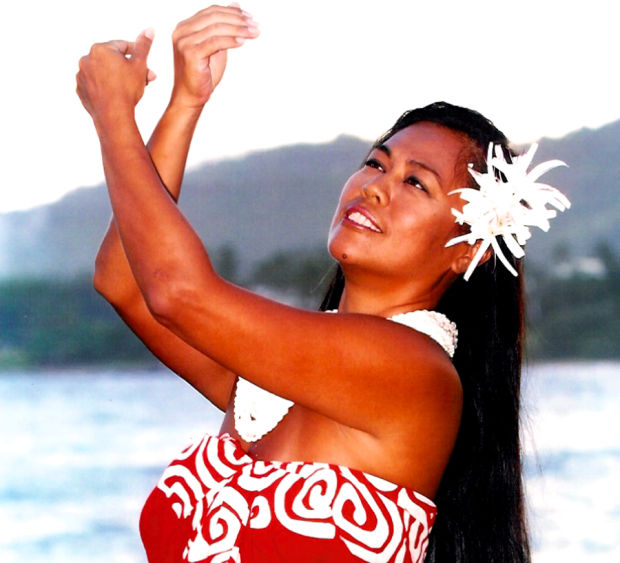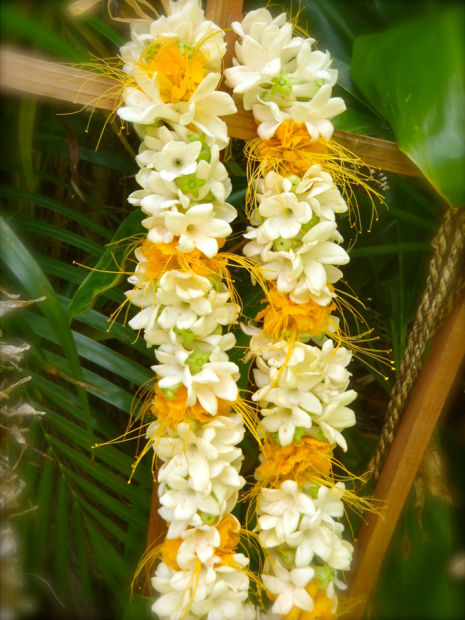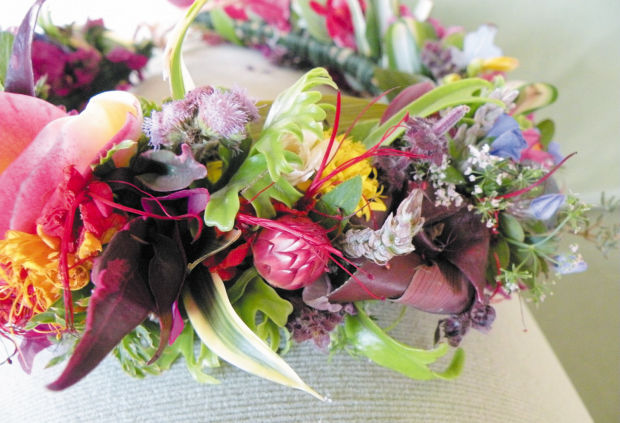For lei-makers Elvrine Chow and Madeline Guyett, perpetuating the lovely Hawaiian tradition of making flower garlands to show aloha or to celebrate someone, is a gift. “Hawaiian people are so graceful. I was never really graceful. But when my sister-in-law,
For lei-makers Elvrine Chow and Madeline Guyett, perpetuating the lovely Hawaiian tradition of making flower garlands to show aloha or to celebrate someone, is a gift.
“Hawaiian people are so graceful. I was never really graceful. But when my sister-in-law, Cashie Lopez, started to teach us how to make lei, I felt like I had found my grace,” says Chow, who settled on Kauai 37 years ago and began making lei more than 20 years ago. (Note: In the Hawaiian language, the word lei is both singular and plural.)
Chow specializes in lei po’o that are worn around your forehead, commonly called haku lei. “When you wear a haku, you feel so special, like a princess,” she says. “Everybody should feel like that all the time!”
Guyett, whose birthday is May 1, celebrated in Hawaii as Lei Day, feels she literally and figuratively “was born to make and celebrate lei.” Born in Los Angeles to parents who immigrated from the Philippines, she moved to Kauai 28 years ago and has felt home ever since.
Both women learned how to make lei through hula, Guyett when she was preparing to dance with a pa hula (hula troupe). She and her hula sisters were required to make their own lei. Chow learned when she and her sisters-in-law had to make lei for their children to wear while performing hula at a baby luau (traditional party celebrating a child’s first birthday).
For both women, a lei is more than a decorative collection of flowers.
“It’s the aloha that’s in your heart – that’s what’s coming through in the lei,” Guyett says.
Agrees Chow, “When I am making a haku, I put as much love into it as I can. I think about the person it’s for and their special occasion. Sometimes it will be for someone who has passed away and the family wants it for the funeral or the urn, and I’m hoping it’s going to make people feel better.”
Both women enjoy entering the prestigious May Day lei contest at the Kauai Museum, each having won awards in the competition. In fact, seeing entries from other lei-makers whom she admires motivates Guyett to keep learning more about the craft.
“Seeing everyone else’s lei is inspiring to me,” she says. “I’ll think, ‘I want to try making one like that’ or ‘I’ve never seen that plant used.’ ”
Chow’s favorite time is after she has stayed up all night creating her lei then dropping them off at the museum in the morning for judging. That’s when she gets to make a lei for herself.
“Sometimes people say, ‘She’s a lei-maker. Why would she want a lei?’ Oh, lei-makers love lei,” says Chow, whose business, Heavenly Hakus, can be found at the Kauai Community College Farmers Market on Saturdays. She also teaches lei-making workshops upon request.
“After I’ve made my lei for the museum contest, my floor is just filled with leftover flowers. I’ll make a beautiful rainbow haku using a little bit of everything that I’ve found that I can wear when I return to the museum when they announce the results of the competition,” Chow says. “That’s the best day because I’m surrounded by everyone else’s lei creations and everyone is wearing a lei. That’s better than Christmas for me.”
Guyett mostly keeps her lei-making as a joyful passion rather than a business though she has branched into making beautiful handmade note cards featuring photographs of her lei. Kinikohu Kards incorporates the use of Guyett’s given Hawaiian name of Kinikohumakalehua, which means “Beauty is the rain with countless lehua blossoms.” Kinikohu Kards are sold at select island locations including Allerton Gardens in Poipu, one of the National Tropical Botanical Garden campuses.
Guyett embraces Hawaiian culture, incorporating it and her love for hula in all aspects of her lei-making. “I always chant Hawaiian chants when I am gathering materials and making lei. There are chants that are specific for gathering or giving lei,” Guyett says. When asked recently to present a lei to Gov. Neil Abercrombie, she stood before him chanting while giving him the lei.
“Hawaiian culture is a gift to me,” she says. “That’s why, like a lei, it’s not just for me to keep. It’s for me to share.”
• Pamela Varma Brown is the editor of the book, “Kauai Stories,” a collection of 50 personal stories told by Kauai people. Read more about lei-makers Elvrine Chow and Madeline Guyett in Brown’s forthcoming new book, “Kauai Stories II.” If you have a lei anecdote you would like to share for possible inclusion in “Kauai Stories II,” contact Brown: pam@kauaistories.net; (808) 651-3533. Visit www.kauaistories.net.




